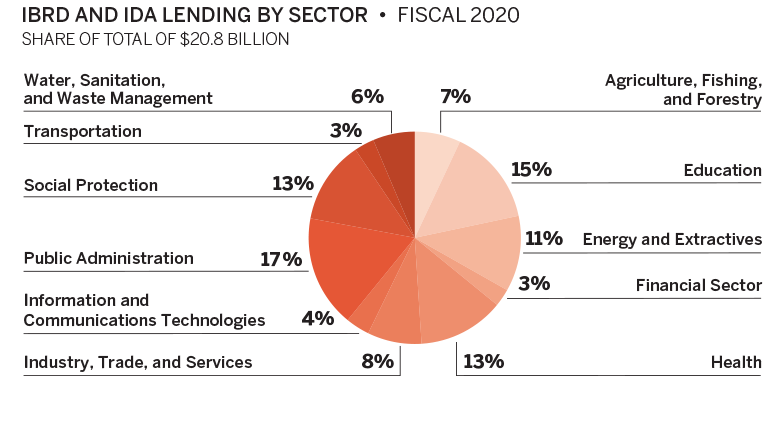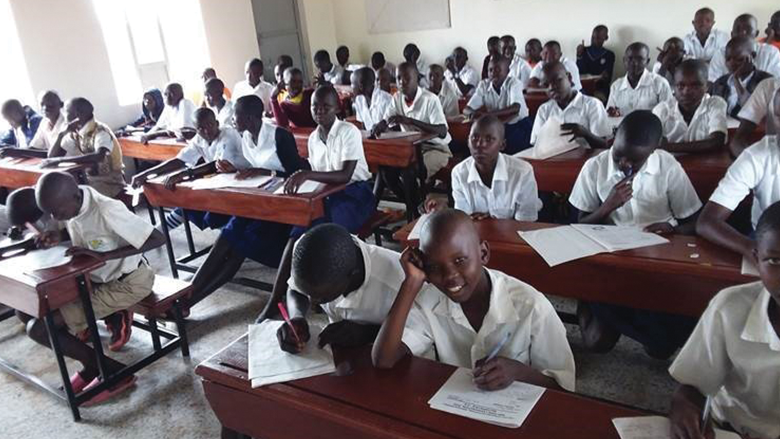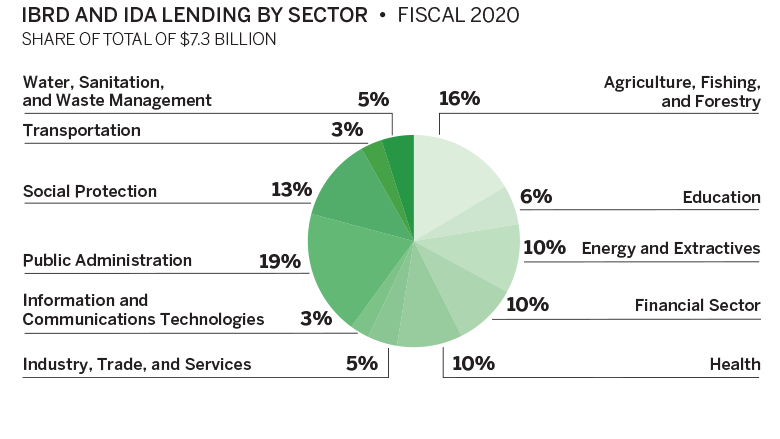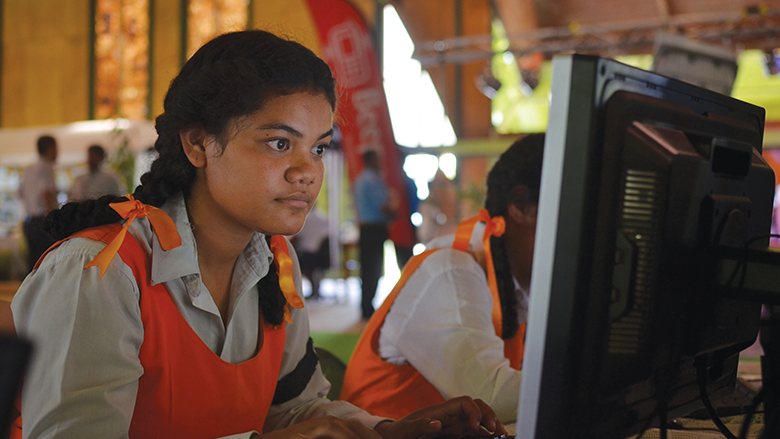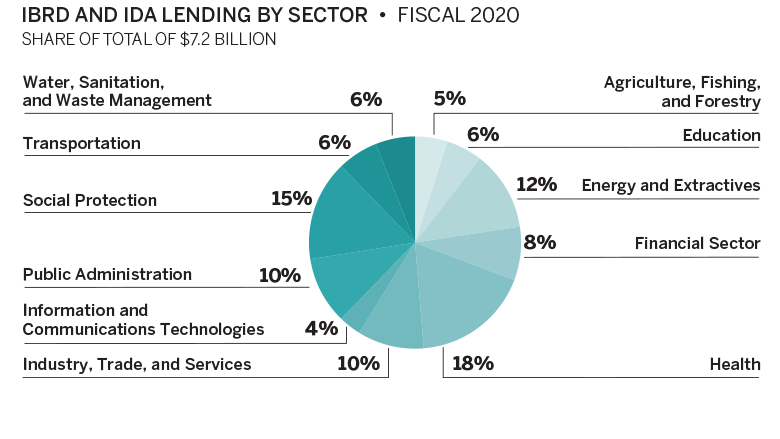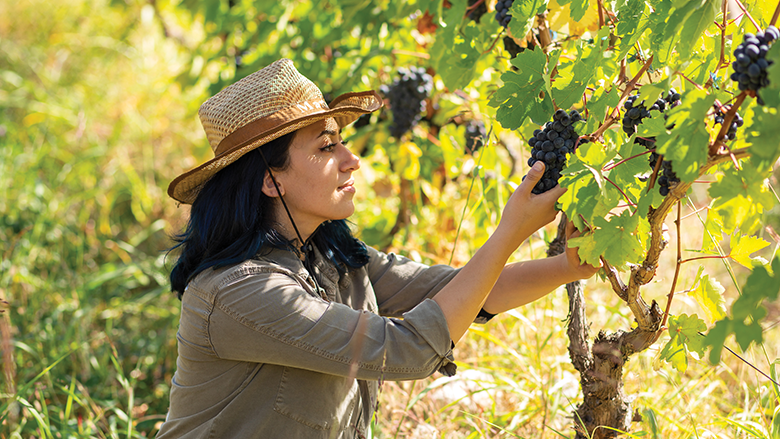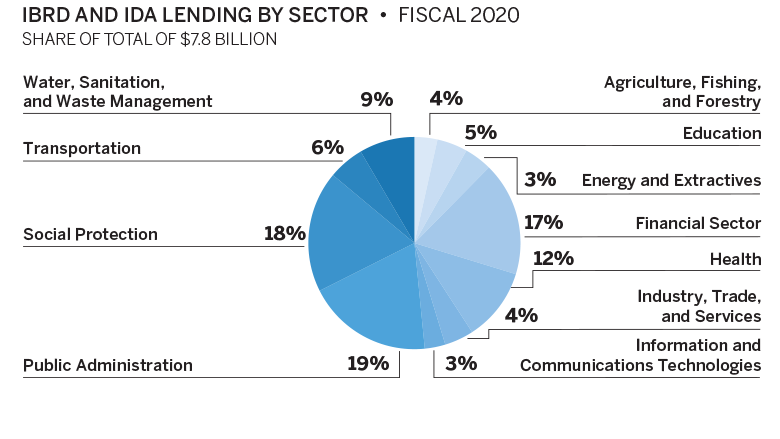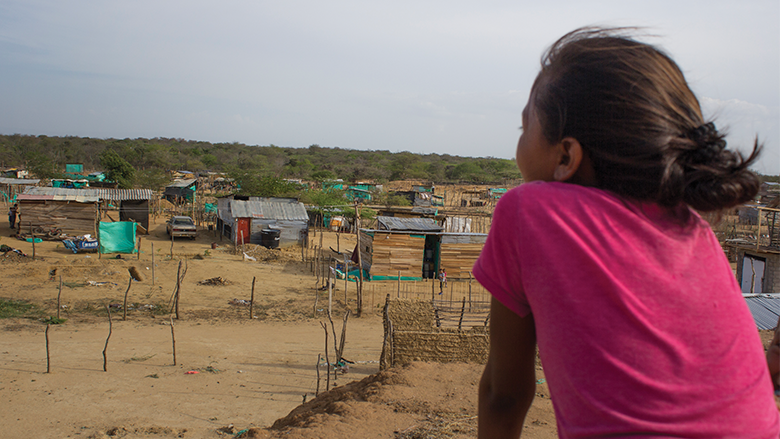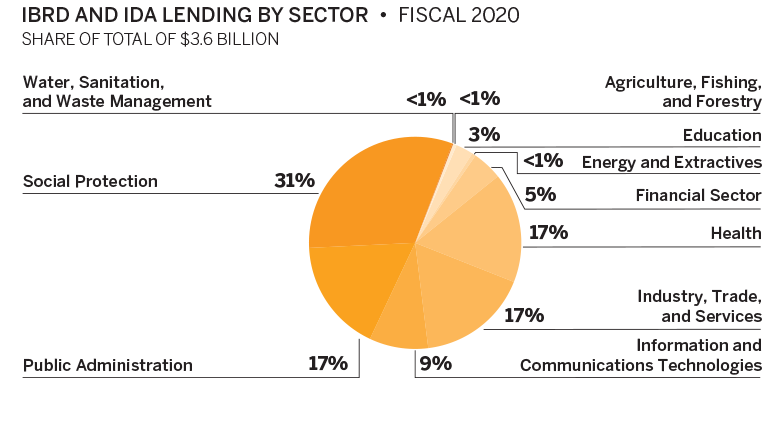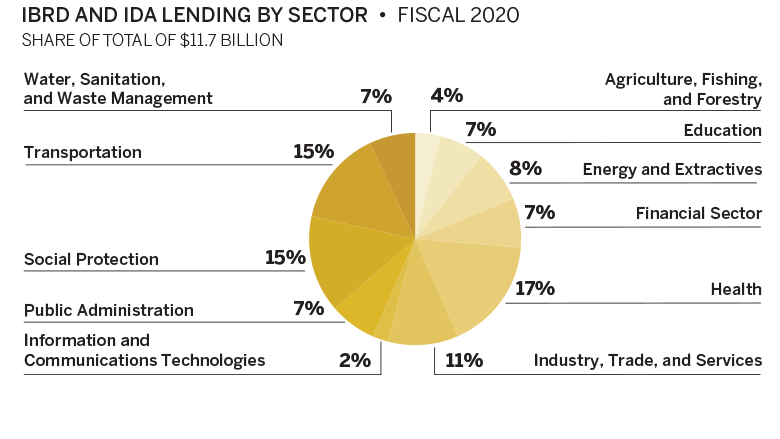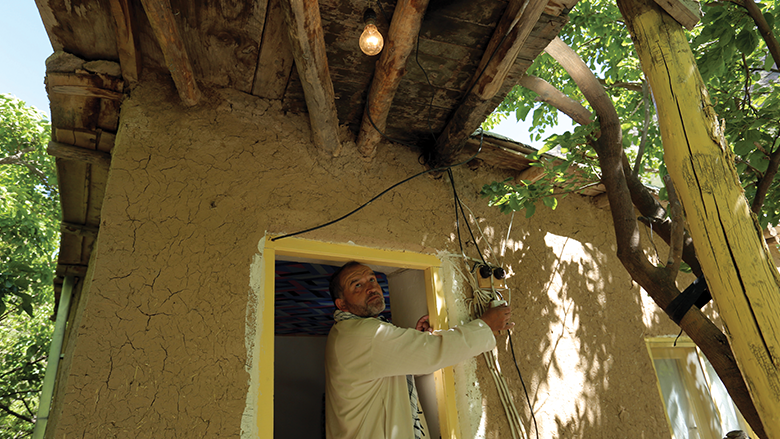Global volatility due to COVID-19 is having a negative impact on Sub-Saharan Africa. The health, economic, and social impacts are costing the region between $37 billion and $79 billion in output losses in 2020, reducing agricultural productivity, weakening supply chains, limiting job prospects, and decreasing remittances—all contributing to uncertainty. Unprecedented locust swarms are further disrupting food security and livelihoods in East Africa. Economic growth is expected to contract from 2.4 percent in 2019 to between –2.1 and –5.1 percent in 2020, sparking the region’s first recession in 25 years. The pandemic is likely to push millions of households into poverty and could spark a food security crisis, with Africa’s agricultural production potentially contracting in the range of 2.6 to 7 percent. With almost 90 percent of the region’s workers in informal jobs, we also seek to help countries reach them with the support they need.
World Bank assistance
In fiscal 2020, the Bank approved $20.8 billion in lending to the Africa region for 156 operations, including $1.7 billion in IBRD commitments and $19.1 billion in IDA commitments. Revenue from Reimbursable Advisory Services agreements with eight countries was $11 million.
We seek to help the region foster human capital and empower women, leverage digital technologies for trade and government effectiveness, maintain public investment and mobilize private financing in critical sectors, encourage job creation, and address the drivers and effects of climate change and conflict.
In fiscal 2020, in response to COVID-19, the Bank approved 28 new operations ($493 million) and redirected funding from 27 existing projects ($476 million) for Africa under the global Strategic Preparedness and Response Program.
Powering Africa’s potential through its people
In April 2019, we launched the Africa Human Capital Plan, which sets out targets and commitments to boost the region’s potential through its human capital—the health, knowledge, skills, and resilience of its people. The plan aims to reduce child mortality and stunting and increase children’s learning outcomes by 20 percent. It also seeks to provide social protection to 13 million more people, empower women, reduce adolescent fertility rates, and improve sanitation practices.
Since the plan’s launch, we have doubled our commitments to boost human capital outcomes in the region, including $2.2 billion to empower women. The flagship Sahel Women Empowerment and Demographic Dividend Project will soon reach nine countries with $675 million in Bank funding. It helps empower women and girls in the Sahel region by increasing their access to education and quality health care, boosting employment opportunities, and engaging religious and community leaders to amplify these results. To date, it has helped more than 100,000 girls go to school, trained more than 6,600 midwives, and implemented vocational training for nearly 100,000 women.
Supporting inclusive governance and transforming economies
Our work on governance and inclusion focuses on enabling efficient and inclusive delivery of public services and building institutions and systems that are resilient to economic, social, and environmental pressures. We help countries create sound conditions for investment and ensure continuity of state services, promoting progress toward sustainable development. Technology has also affected how governments operate and interact with citizens, improving transparency and service delivery.
We leverage all sources of financing and expertise to help create an enabling environment for investors, particularly those in the private sector. This approach will open up more opportunities for governments and companies to scale up critical infrastructure, expand digital access, and generate employment. We are also working with countries to realize a rapid transition to the digital economy, which can boost productivity, increase financial inclusion, and create jobs. The region is working to connect every African individual, business, and government to the internet by 2030.
In March 2020, Somalia began receiving debt relief under the enhanced Heavily Indebted Poor Countries (HIPC) Initiative to help the country reduce its debt from$5.2 billion at the end of 2018 to $557 million once it reaches the HIPC Completion Point in about three years’ time. The Bank played a strong role in helping Somalia achieve this milestone, including $140 million in pre-arrears clearance grants in fiscal 2019 and $475 million in development policy financing to strengthen state capacity, financial management, and transparency, and promote inclusive private sector–led growth.
Addressing the drivers of fragility and conflict
Addressing fragility, conflict, and violence (FCV) is a priority of the region’s Human Capital Plan, as these issues continue to limit opportunities. Access to education and vocational training is limited, leaving many young people with few marketable skills. Private sector growth is constrained, with few openings for job seekers. And security concerns limit the provision and quality of public service delivery.
In fiscal 2020, we invested $2.5 billion in countries affected by FCV. In the Central African Republic, which has experienced cycles of violence and conflict since gaining independence in 1960, we have helped strengthen governance, public financial management, and service delivery following the signing of a peace agreement in February 2019. We also produced analytical work outlining ways for the country to realize inclusive growth, including by enhancing public services, strengthening the social contract, broadening the tax base, and modernizing the tax system.
We will build on this progress with more investments and high-quality interventions, including additional funding under IDA19 for cross-border programs in the Sahel, the Lake Chad region, and the Horn of Africa. These efforts will also seek to address the different risks and opportunities that women and men face in FCV situations.
Supporting climate change mitigation and adaptation
With the poor in Africa hardest hit by climate change, investments in climate resilience are a top priority. The region has set new targets to support integrated landscape management of more than 60 million hectares in 20 countries, improve the livelihoods of 10 million farmers through climate-smart agriculture, and increase renewable energy generation capacity from 28 to 38 gigawatts.
The Africa Climate Business Plan (ACBP), launched in 2015, and the updated Next Generation ACBP are grounded in the Bank Group’s commitment to mainstream climate into development. As of December 2019, more than $30 billion of Bank financing has been delivered for 312 projects, exceeding the plan’s 2020 resource mobilization target. The updated plan builds on the achievements and lessons of the original ACBP to propel a bold vision for climate action at scale.
Stepping up to support regional integration in Africa
The Bank Group is expanding support for regional integration, including fostering linkages with North Africa, to address the key priorities of the continent’s 54 countries. We are focusing on: strengthening connectivity through infrastructure development in transport, energy, and digital technology; supporting trade and building markets; improving human capital by providing opportunities for skills development, empowering women, and managing diseases and pandemics; and promoting resilience through work on farming and livestock, food security, climate change, displacement, and transboundary waters. We also aim to address the drivers of fragility in the Horn of Africa, the Lake Chad region, and the Sahel.
The Regional Disease Surveillance Systems Enhancement Program covers 16 countries and provides $629 million in financing. It strengthens health systems and intercountry collaboration to detect and respond to outbreaks of communicable diseases. The Bank has also provided $250 million to help Ethiopia, Zambia, and the African Union implement the Africa Centers for Disease Control and Prevention project, to counter the spread of infectious diseases and address regional and continent-wide public health issues. Both projects have now mobilized resources to help countries procure laboratory equipment and increase their capacities to address the COVID-19 pandemic.
Locust swarms are jeopardizing the food security and livelihoods of millions of people in the region. We are helping countries respond to this threat through the $500 million Emergency Locust Response Program, which provides support for monitoring and controlling locust populations, helping people safeguard their assets and cope with the economic impacts, and strengthening national preparedness systems. The program has provided financing to Ethiopia, Kenya, Somalia, and Uganda to support their response efforts.
Further Information: Africa Region Homepage >
Regional Commitments and Disbusements for Fiscal 2018–20
| | Commitments ($ millions) | Disbursements ($ millions) |
| | FY18 | FY19 | FY20 | FY18 | FY19 | FY20 |
| IBRD | 1,120 | 820 | 1,725 | 734 | 690 | 1,087 |
| IDA | 15,411 | 14,187 | 19,095 | 8,206 | 10,190 | 13,373 |
| Portfolio of operations under implementation as of June 30, 2020: $88.2 billion. |
SPOTLIGHT: Supporting refugees and host communities in Uganda
With a refugee population of 1.4 million, Uganda is Africa’s largest host of refugees and the world’s third largest. Despite the country having some of the world’s most progressive and generous refugee policies, refugees experience practical challenges in securing livelihoods and social services. This is due in part to their protracted presence and the fluid nature of new arrivals. These trends have increased demand for local services in hosting areas and on communities that are themselves underserved, underlining the need for long-term investments.
The Bank is supporting Uganda through the $150 million Development Response to Displacement Impacts Project, which secured financing from IDA’s sub-window for refugees and host communities. The project is improving access to basic social services, expanding economic opportunities, and upgrading social and economic infrastructure. It also supports natural resource management and environmental regeneration.
The project covers 14 districts in Uganda that host the largest number of refugees. It has a larger footprint in the north, where the focus is on graduating from an emergency response to a medium-term perspective; in the west and southwest, it centers on enhancing economic opportunities and integrating district and national service delivery systems. A Displacement Crisis Response Mechanism provides financing that enables the government to rapidly scale up education, health, and water supply services to poor and vulnerable communities that may face a rapid inflow of refugees.
In Koboko, northwestern Uganda, we are easing overcrowding and improving the learning environment in Lobule primary school by building new classrooms, with upgrades such as rainwater harvesting tanks, better lighting, and drainable latrines. In total, about 80 facilities have been built and nearly 100 are under construction; they include classrooms with modern furniture, teachers’ houses, health centers, public latrines, water harvesting tanks, and veterinary clinics. The project is also helping rehabilitate degraded lands, improve the sustainability of water sources, and maintain fertile croplands and forests. Renovations are becoming more user-friendly by using alternative energy, such as solar energy for lighting and water pumping, and better household cook stoves.
To help both refugees and host communities thrive, a livelihoods program is helping create, expand, and improve opportunities for people to earn income, including in value-added agriculture, fisheries, and charcoal and brick production.
The project is part of a larger regional effort to support communities hosting refugees in Djibouti, Ethiopia, Kenya, and Uganda. Through a community-driven development approach, it ensures citizen participation and engagement in identifying and prioritizing sub-projects that address urgent community needs, empowering not only the community but also grassroots institutions and decentralized government bodies. The project also seeks to address underlying social risks, including gender-based violence and violence against children. The overarching goal is to enhance social cohesion among refugee and host communities, improve social accountability, and integrate humanitarian and development programs for the benefit of all.
Regional Snapshot
| Indicator | 2000 | 2010 | Current Dataa |
| Total population (millions) | 664 | 868 | 1,106 |
| Population growth (annual %) | 2.7 | 2.8 | 2.7 |
| GNI per capita (Atlas method, current US$) | 550 | 1,434 | 1,536 |
| GDP per capita growth (annual %) | 0.8 | 2.6 | 0 |
| Population living below $1.90 a day (millions) | 388b | 405 | 420 |
| Life expectancy at birth, females (years) | 52 | 58 | 63 |
| Life expectancy at birth, males (years) | 49 | 55 | 60 |
| Carbon dioxide emissions (megatons) | 565 | 765 | 848 |
| Extreme poverty (% population below $1.90 a day, 2011 PPP) | 55.4b | 46.6 | 42.3 |
| Debt services as a proportion of exports of goods and services | 9 | 3 | 8 |
| Ratio of female to male labor force participation rate (%) (modeled ILO estimate) | 84 | 85 | 86 |
| Vulnerable employment, total (% of total employment) (modeled ILO estimate) | 78 | 76 | 74 |
| Under-5 mortality rate per 1,000 live births | 153 | 101 | 78 |
| Primary completion rate (% relevant age group) | 54 | 68 | 69 |
| Individuals using the Internet (% of population) | <1 | 7 | 25 |
| Access to electricity (% population) | 26 | 34 | 48 |
| Renewable energy consumption (% total final energy consumption) | 73 | 72 | 70 |
| People using at least basic sanitation services (% of population) | 23 | 27 | 31 |
| People using at least basic drinking water services (% of population) | 46 | 55 | 61 |
Note: ILO = International Labour Organization; PPP = purchasing power parity.
a. The most current data available between 2013 and 2019; visit http://data.worldbank.org for data updates.
b. 2002 data. For poverty estimates, see the regional groups on http://iresearch.worldbank.org/PovcalNet/data.aspx. |
